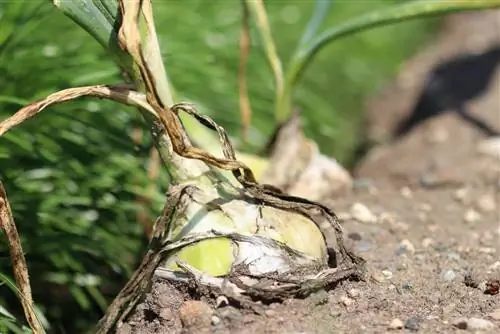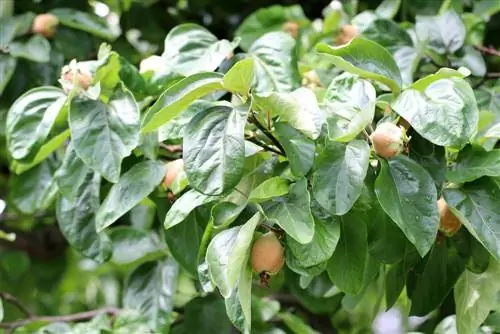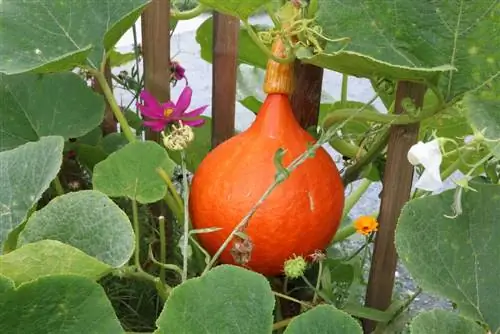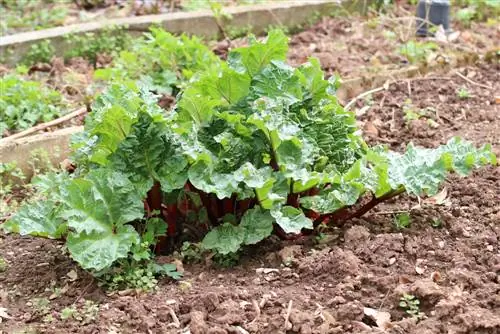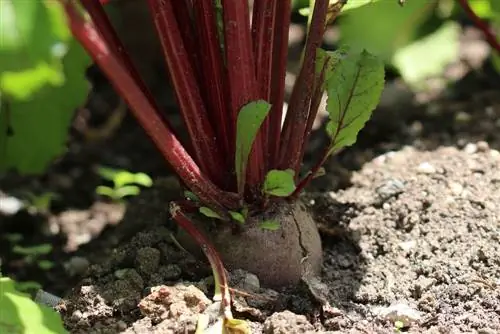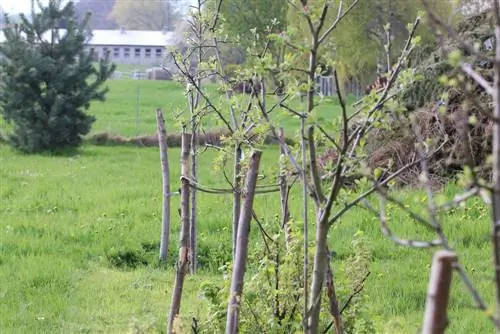- Author admin [email protected].
- Public 2023-12-17 03:39.
- Last modified 2025-01-24 12:45.
The optimal harvest time for onions cannot be determined so easily by determining a time period. The time of harvest, the way in which it is harvested and the further treatment of the onion have a major influence on the quality and, above all, on the further shelf life. The type of cultivation and onion variety play an important role. But the weather at harvest time also determines how the Allium cepa needs to be treated after it has ripened.
Time
The harvest time for the popular kitchen onion is sometime between June and September. The exact period depends on whether the onions were sown or whether onion sets were planted. Of course, the time of sowing, or the time when the onion sets were planted, also plays an important role in the harvest time. The exact date is ultimately determined by the weather and the onions themselves.
Growing method
When growing, a distinction is made between sowing onion seeds and setting onion sets. Another distinction is whether the onions are summer or winter and which type of onion you have chosen.
Planting onion sets is not as difficult to care for as sowing onion seeds. If you plant winter onion sets in the fall, you can harvest early next year. However, onion sets generally do not store as well as seed onions.
Sowing onions
The harvest time for sowing onions depends on the type of onion, whether it is a winter or summer onion. Then it depends again on when exactly the seeds were sown in autumn or spring.
- If the seeds are sown in March or April, you can expect the harvest between August and September. These are the seeds for summer onions.
- If you sow winter onion seeds in August, you can expect the harvest from June or July of the following year.
Onion sets
Both types of onion sets are also represented, summer and winter onions. Here the situation is similar to sowing:
- If you plant the winter onions in autumn (September, October), you can start harvesting from the end of June of the following year.
- If the onion sets are only planted in spring, in March or April depending on the weather, the harvest can only take place later, usually from August.
Onion varieties
When shopping, you first decide which type of onion you would like to plant. Only then do decisions are made on a precise selection of varieties, on sets or seed onions, for spring or autumn. There is also the option of initially growing onion sets yourself from seed onions and then using them next year either in autumn or spring. For the culinary aspect in the kitchen you can choose from:
- household onion
- Vegetable onion
- Pearl Onion
- Shallots
- Red Onion
- White Onion
- Spring Onion
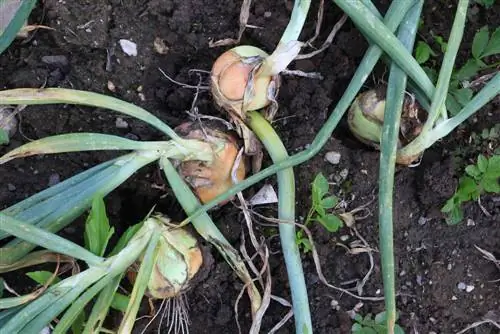
Now we can go into further detail. For example, whether sufficient winter hardiness is required for autumn planting or whether you want to do a lot of work (sowing) or less work (planting onions). What are the storage options? And when should we start harvesting?
Some popular varieties:
Onion set 'Stuttgarter Riesen'
They are large, yellow and store very well. In addition, they cope with the cold very well. The sowing and planting of the onion sets can be done very early in the spring when planting in summer.
Seed or onion set 'Zittauer Gelbe'
They are characterized by a firm, spicy and fine-skinned tuber. They last very well. In the same year, planted or sown as summer onions, they are ready for harvest from July.
Winter onion set 'Presto'
The Presto is large and round with a fine shell. As an onion set, it promises an early harvest, a high yield and can be stored for up to four months.
Winter seeds 'Express Yellow'
A popular yellow onion of the quick variety. It can be sown in August and harvested in late spring or early summer.
Onion set ‘Red Karmen’
It is dark red and quite spicy. Extremely bolt-resistant and can be harvested as early as July. The Red Karmen can be stored until December.
Identify harvest time
Of course, you can roughly limit the time of harvest by selecting the onion variety and the time of planting. However, the exact harvest day depends solely on what the onions look like and, if possible, also on the weather.
You have to know that the onion slowly prepares for winter in the summer. This means that the nutrients from the leaves are stored in the tuber. This causes the leaves to yellow and wilt. This process runs from the leaf tips down to the tuber. The onions are at their peak ripeness when:
- at least a third of the foliage is yellowed and dry
- the onion leaves, mostly dry, lie on the ground
It is best to harvest the onions in dry weather. This means the onions can continue to ripen on the bed in peace and dryness.
If the right time for harvesting is not adhered to, then it can happen that
- the storage capacity suffers (harvest too early)
- the peels fall off and the onion sprouts quickly (harvest too late)
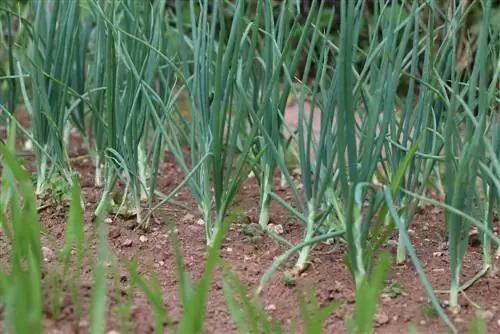
Dry weather during harvest is optimal. This is important for the storage ability of the onions. If the weather is dry and warm, you can speed up the ripening process a little. To do this, use a digging fork to loosen the onion root slightly from the ground. This stops growth and draws remaining nutrients from the leaves.
This method is more effective than the traditional trick of simply kicking the leaves closed. This only initiates emergency ripening and diseases or pests can easily penetrate the onion. The onion is then more prone to rot and significantly loses its storage ability.
Tip:
You should stop watering a few weeks before the harvest is due. A warm, dry soil helps the foliage dry out. This promotes the development of the onion and allows it to be stored for longer.
Harvest
When the weather is nice
If you are lucky enough to catch a few dry days for the onion harvest, you leave the harvested onions on the bed. The loose peels are removed and the onions are freed from the soil. Now it's time to turn it every two days. 10 days would be optimal for this process. One speaks of the after-ripening period. This gives the onions a firm, thick skin and is perfect for storage. The onions can then be freed from leaves, spread out in a fruit box and placed. Or you can tie them together with the leaves in bundles, traditionally braided, and hang them in a dry place.
In wet weather
In rainy weather you cannot leave the onions on the bed. The onions must be spread out in fruit boxes in a covered place to dry. It is important that each onion gets enough air. Whenever the sun shines, the boxes can be put out.
Of course, as soon as real onion bulbs are visible, you can harvest them for immediate consumption. If possible, slightly damaged onions should also be consumed immediately and only the undamaged specimens should be allowed to ripen for storage.
Tip:
If you garden close to nature, you can simply leave some onions in the bed. These will then bloom the next year. The bees and other nectar suckers are happy about this.
Storage
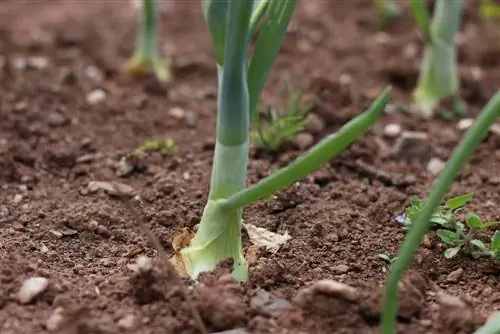
The variety, time of harvest and ripening are important parameters for how long you can store your harvested onions. The following conditions are optimal for storage itself:
- Storage temperature relatively cool
- no frost and no temperatures above 28°C
- dry and airy storage location
- best stored in a dark place
- do not store with potatoes or fruit
- do not rotate during storage
- Check and sort out damaged, sprouted and rotten onions from time to time
- Storage in a basket, in fruit boxes, in the net
Conclusion
Processing your own grown and harvested onions in the kitchen simply gives you a good feeling. As medium-feeders, the onion plants are not too demanding to care for. If you want to store them for longer, you should consider a few things when selecting the variety, harvesting and subsequent storage. The basic rule is: the wetter the onions are harvested, the shorter the ripening time, the shorter the storage time.

